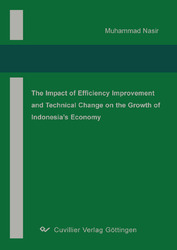| Areas | |
|---|---|
| Serie de libros (96) |
1378
|
| Nachhaltigkeit |
3
|
| Gesundheitswesen |
1
|
| Letra |
2363
|
| Ciencias Naturales |
5406
|
| Matemática | 229 |
| Informática | 319 |
| Física | 980 |
| Química | 1363 |
| Geociencias | 131 |
| Medicina humana | 243 |
| Estomatología | 10 |
| Veterinaria | 108 |
| Farmacia | 147 |
| Biología | 835 |
| Bioquímica, biología molecular, tecnología genética | 121 |
| Biofísica | 25 |
| Nutrición | 45 |
| Agricultura | 1004 |
| Silvicultura | 201 |
| Horticultura | 20 |
| Ecología y conservación de la tierra | 148 |
| Ciencias Ingeniería |
1791
|
| General |
98
|
|
Leitlinien Unfallchirurgie
5. Auflage bestellen |
|
Erweiterte Suche
The Impact of Efficiency Improvement and Technical Change on The Growth of Indonesia’s Economy (Tienda española)
Muhammad Nasir (Autor)Previo
Indice, Datei (24 KB)
Lectura de prueba, Datei (99 KB)
Technological change has a positive role on Indonesian economic growth.
Furthermore, foreign direct investment (FDI) as the means of technological transfer also
has a positive role on Indonesian economic growth. This study investigates four inherently
interconnected issues: the growth rates of output and inputs and also differences between
sectors; the role of technological change on economic growth; government policies toward
supporting economic growth; and the role of FDI on economic growth. The central research
issue is on exploring the contribution of technological change on Indonesian economic
growth. By modeling the role of technological change as a Malmquist index as applied by
Coelli et al. (1998) and the role of FDI on economic growth, this study investigates the role
of technological change and FDI on Indonesian economic growth. Using time series data
for the period of 1971-2005 for Indonesia, the results show that Indonesian economic
growth fluctuates over time, meanwhile labor fluctuates less compared to capital. So far,
foreign direct investment (FDI) inflow shows broadly fluctuation over time.
The role of technological change was analyzed using Data Envelopment Analysis
(DEA)-like Malmquist index as applied by Coelli et al. (1998). The analysis was broken by
the economic sectors in Indonesia and also by incorporating undesirable CO2 emission
output. The results show that agriculture sector has consistently technological progress for
the years of 1998-2004. In addition, manufacturing, and transportation & communication
sectors show mostly technological progress over the years of analysis (1992-2004). The
other sectors also show technological progress in some respective years. Furthermore,
mining sector has been found as the benchmark for the other sectors in the efficiency
analysis. With the efficiency change always one for all the years of the analysis mining has
been very efficient sector over the years. Generally, all of the economic sectors have shown
efficiency improvement after the economic crisis (Asian crisis), some of them have been
efficient after the year 2000.
Meanwhile, the regression results based on the FDI model applied by Tang et al.
(2008) shows that FDI has a cointegration on Indonesian economic growth for the time of
analysis. Nevertheless, the long-run relationship was found not significant as the result of
broadly variations in FDI inflow for Indonesia. On the other hand some control variables
show significant long-run relationship with Indonesian economic growth.
The major policy implications are that the government policies in supporting
technological change and economic growth in Indonesia are on the right track. So far, the
government has released a number of favorable policies. Nevertheless, the government
policies on generating public research and development (R&D;) found still not favorable. In
the future, government should put more attentions on spending more on R&D; and also
education sector in better supporting technological progress and economic growth in
Indonesia.
| ISBN-10 (Impresion) | 3867277745 |
| ISBN-13 (Impresion) | 9783867277747 |
| ISBN-13 (E-Book) | 9783736927742 |
| Idioma | Inglés |
| Numero de paginas | 192 |
| Edicion | 1 Aufl. |
| Volumen | 0 |
| Lugar de publicacion | Göttingen |
| Lugar de la disertacion | Universität Bonn |
| Fecha de publicacion | 22.10.2008 |
| Clasificacion simple | Tesis doctoral |
| Area |
Agricultura
|








